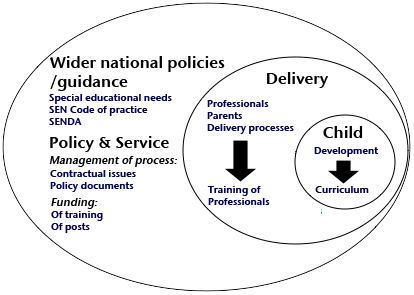Entrance Hall
Possible uses for this online resource
The aim of this online resource is to help users to understand and consider the different factors that are involved in the delivery of mobility and independence education to children with visual impairment. In particular the M&I skills that need to be covered in an M&I curriculum; how these skills can be ‘delivered’ to children including a description of the various stages and processes and people that are involved, and considering the needs of particular groups of children; the key considerations to make when developing an M&I service including the training and background of professionals and issues relating to multi-agency provision; and the implications of national educational policies upon the provision of M&I education.

Whilst different users of this resource may come with very individual, pre-defined learning aims, it is important to understand that it is impossible to consider one area in isolation from other areas, as other areas will affect and impact upon that area. Therefore, whilst it is possible to study one of the rooms in isolation, a fuller understanding will be achieved if all or several of the rooms are studied. Links to information in other rooms are provided where we have decided it is appropriate and deemed to be useful to the user.
Important note: Ultimately, it is the interactions between the tutor and the pupil and the related practice that drives the pupil’s learning and development. While these pedagogical issues are vital, they are not the focus of this resource. The resource assumes the effective delivery of mobility and independence education is dependent upon these pedagogical factors. While it makes recommendations about people who should be involved and the broad procedures that should be followed, this research does not set out to make recommendations about teaching strategies.
Background to the resource
The Steps to Independence website was developed and is hosted by the National Library for the Blind.
The content authors are Sue Pavey, Graeme Douglas, Mike McLinden, and Steve McCall of the Vision Impairment Centre for Teaching and Research (VICTAR) at the University of Birmingham.
This online resource is based upon the findings of a research project that investigated the mobility and independence needs of children with a vision impairment who are educated in mainstream schools. The research project was proposed and funded by The Guide Dogs for the Blind Association, Opsis, RNIB and the Department for Education and Skills.
Although survey work had indicated that the provision of mobility and independence education to children was patchy and inconsistent within the UK, little research had been carried out investigating how best to provide mobility and independence education. The research project considered factors which play a part in mobility and independence education. These included the definition and boundaries of a mobility and independence curriculum, the delivery of such a curriculum, the identification and training of the key people involved in this process, and the funding of this training and the posts. The research team, hereafter referred to as ‘we’ or ‘us’, based within the Vision Impairment Centre for Teaching and Research (VICTAR) at the University of Birmingham, carried out the one-year project during 2001. Two final reports were produced, one a full research report, the second a shorter recommendations and summary report.
Acknowledgements
We would like to thank all of the many individuals, agencies and organisations who took part in the research project, and everyone who offered help and guidance. We were very encouraged by the enthusiasm of all those we spoke to who are involved in mobility and independence education.
In particular, we would like to thank the members of the Mobility and Independence Specialists in Education (MISE) group for their many contributions to the research as a group, and as individuals.
Acknowledgement is also due to the members of the management and advisory groups for their continued advice and guidance throughout the project. The DfES, The Guide Dogs for the Blind Association, OPSIS and RNIB jointly funded this research. However, the views expressed and recorded here are those of the research team. They do not necessarily reflect the views of the sponsoring agencies. We would also like to thank The Health Foundation for making this online resource possible.
Next Section